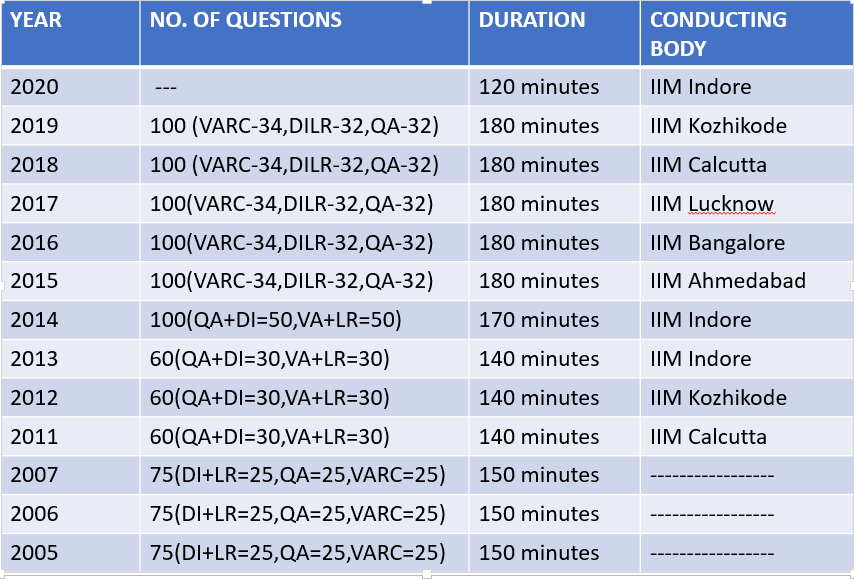Like all things in 2020, the Covid has created certain constraints, and CAT 2020 has also decided to shock us with their announcement on 15th September that the exam duration for CAT 2020 has been reduced from 3 hours to 2 hours, with each section having an individual time limit of 40 minutes. Many speculations have been making rounds since the release of the CAT 2020 notification by IIM Indore. Lets deep-dive into what can be in store for you on 29th November.
Some of the central questions arising in everyone’s minds are:
- Will the number of sections in every section remain the same as CAT 2019?
- Will the number of questions across each section be reduced?
- How many TITA(non-negative) questions would be there in each section?
- How will the cut-off vary across the sections, and what would the Level of Difficulty be?
Everything looks grey around these assumptions, and the only thing that is sure is that the pattern and type of questions across the three sections (VARC, DILR, QA) would remain the same, and the time across each section would be uniform (40 mins).
One of the quite obvious speculations around CAT 2020 is around a 33% drop in the number of questions across the three sections as the time duration to attempt the exam has been reduced to two hours from the previous time limit of three hours.
CAT has been evolving over the years in terms of mode of examination, a number of questions, registered students, exam patterns, and so forth. It has been observed that IIMs over the past few years have introduced a wide variety of changes from the number of hours to the number of questions across various sections to avoid becoming predictable by the test-takers. The exam pattern of CAT has always added some new concepts every year to cope up with the growing competition among the candidates of the exam. The evolution and variations in the CAT exam pattern, the admission criteria of the IIMs, and the way it is conducted are the main reasons why CAT is one of the toughest exams in the country, and getting good marks to get into IIMs is not a cakewalk.
In the past six years, the marking scheme of the CAT exam has also not changed. For each correct answer, three marks are allotted, and for each wrong answer, -1 mark is deducted, and there’s no deduction of marks for TITA questions and questions left unattempted. However, watching the trends of the past 12 years of the CAT exam pattern, one cannot fail but notice that the test structure of the CAT exam witnessed an enormous change in 2013-2014 in terms of duration and number of questions. While in CAT 2013, the number of questions was 60 and therefore, the time duration was 140 minutes; in CAT 2014, the number of questions increased to 100, and therefore, the time duration was increased to 170 minutes.
Also Read: CAT 2020 Paper Pattern Changes, To Be A Two Hour Test Instead of A Three Hour Test
On the opposite hand, the number of sections kept changing from three to 2 to 3 again between 2010 and 2015. Between 2011 to 2014, the number of sections was two. The DI section of the CAT exam was clubbed with QA, and the LR section was clubbed with VARC. Given below is a table depicting the evolution in the CAT exam pattern over the years.

As, per my analysis, there are some bright sides to this change of pattern:
- Maintaining an attention span of 2 hrs is much easier than for a 3 hrs exam.
- With more no. of slots required to ease the student movement & safety on the D-day, this seems the right solution.
- Although I am sure the exam difficulty level is not going to reduce, a reduction in the total no. of questions is expected.
All things remaining the same, I think CALMNESS will be the differentiating factor between 2 well-prepared students. The less you panic in a short window of 2 hrs, the better results you will earn. Extra efforts will definitely be required for the mind shift.
XAT Scores No Longer Valid For Admission To SPJIMR's PGDM Program
My prediction is that no. of questions will reduce to 23-24-23 across VARC, DILR, and QA.
Well, the bottom line from my end is that: A player who is well-practised can play well in the ODI as well as the T20 format so, pull up your socks and step into the game with the thought that, if you were good at the three-hour game, you will adjust very quickly and do well in the two-hour game as well.
***
If you liked this article, we recommend you to read the following:
Making The Best Use Of The Last 45 Days For CAT 2020
How CAT 99 Percentilers Attempt Mock Tests - 10 Strategies By 10 CAT Toppers
IIM Bangalore To Give Profile More Weight Than CAT 2020 Score | IIM-B's Latest Admission Policy
